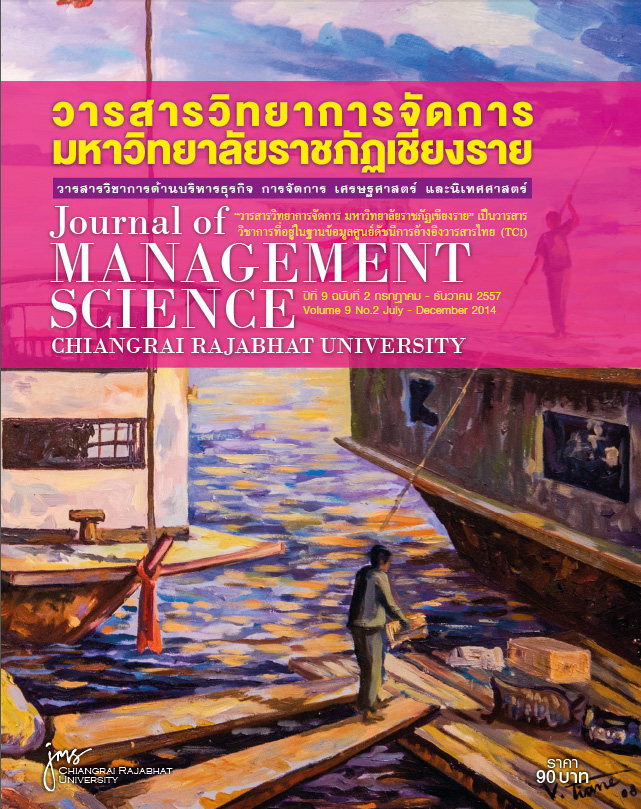The Casual Relationship Among Entrepreneurial, Marketing Capabilities, Innovation and Business Strategy toward Competitive Advantage of Small and Medium Enterprises in Lanna of Thailand
Main Article Content
Abstract
The study of the casual relationship among entrepreneurial, marketing capabilities, innovation and business strategy toward competitive advantage of small and medium enterprises in Lanna of Thailand was a mix methodology research. The sampling group was 465 small and medium enterprises from 8 provinces, i.e. Chiangrai, Chiangmai, Nan, Prayao, Prae, Maehongsong, Lampang and Lamphun. It was stratified sampling technique, data analysis with descriptive statistics to find percentage, average, standard deviation and inferential statistics content analysis with structural equation model. The outcomes of casual relationship analysis revealed that entrepreneurial factor had highest direct effect toward marketing capabilities and followed with entrepreneurial had direct effect toward business strategy and lastly, entrepreneurial had direct effect toward innovation. The entrepreneurial factor also had indirect effect toward competitive advantage through marketing capabilities, innovation and business strategy. The marketing capabilities had direct effect toward innovation and competitive advantage while innovation had direct effect toward competitive advantage and business strategy. Lastly, business strategy had direct effect toward competitive advantage. This research discovered strategy theory of small and medium business. It concluded that competitive advantage of small and medium business derived from entrepreneurial and the appropriate assignment of business strategy by entrepreneurs.
Article Details
Views and opinions expressed in the journal do not necessarily reflect those of the editors.
References
ส่งเสริมวิสาหกิจขนาดกลางและขนาดย่อม (สสว.).
_______. (2556). รายงานสถานการณ์วิสาหกิจขนาดกลางและขนาดย่อม ปี 2556 และแนวโน้มปี 2557.กรุงเทพฯ:สำนักงานส่งเสริมวิสาหกิจขนาดกลางและขนาดย่อม(สสว.) Afzal,S. (2010).“Marketing Capability,Strategy and Business Performance in Emerging Markets of Pakistan,”IUB Journal of Social Sciences and Humanities.7(2):88-102. Bannock, G. (2005). The Economics and Management of Small Business: An International Perspective. London : Routledge. Bougheas,S. , Mizen,P. , & Yalcin, C. (2006). “Access to external finance: Theory and evidence on the impact of monetary policy and firm-specific characteristics,” Journal of Banking and Finance. 30: 199-227. Bygrave, W. D. , & Hofer, C. W. (1991). “Theorizing about entrepreneurship,” Entrepreneurship Theory and Practice.16(2) : 13-22. Chen, M. , & Hambrick, D. C. (1995). “Speed, stealth, and selective attach: How small firms differ from large firms in competitive behavior,” Academy of Management Journal. 38(2) : 453–482. Covin, J. G. , & Slevin, D.P. (1991). “A conceptual model of entrepreneurship as firm behaviour,” Entrepreneurship Theory and Practice. 16(1) : 7-25. Damanpour,F. ,Szabat, K. A. , & Evan,W.M. . (1989).“Therelationshipbetweentypes of innovation and organizational performance,” Journal of Management Studies. 26(6) : 587-601. Gibbons, A. (1997).Innovation and the Developing System of Knowledge Production. University ofSussex. Halit, K. (2006).“Marketorientation, learningorientation,andinnovationcapabilities in SMEs an extended model,” European Journal of Innovation Management. 9(4) : 396-417. Johne, A. (1999). “Successful market innovation,” European Journal of Innovation Management.2 :6-11. Klongan, G. E. , & Goward, E. W. (1976). Rural Sociology. Bangkok: M.S. Thesis Kasetsart University. Kuratko, D. F. , & Hodgetts, R. M. (2004). Entrepreneurship: Theory, Process and Practice. Mason, Ohio: ThomsonSouth-Western. Liu, S. , Luo, X. , & Shi, Y. (2002). “Integrating customer orientation, corporate entrepreneurship, and learning orientation in organization-in-transition: An empirical study,” Internal Journal of Research in Marketing. 19: 367-382. Low, M. B. , & MacMillan, I. C. (1988). “Entrepreneurship: Past research and future challenges,” Journal of Management.14: 139-162.
Miles, R. , & Snow, C. (1978). Organizational Strategy, Structure and Process. New York: McGraw Hill. Morgan, N. A. , Vorhies, D.W. , &Mason, C. H. (2009).“Marketorientation, marketing capabilities and firm performance,” Strategic Management Journal. 30(8) :
909–920. Michaels, E. T. , & Gow, H. R. (2008). “Market orientation, innovation and entrepreneurship: An empirical examination of illinois beef industry,” International Food and Agribusiness Management Review. 11(3) : 56-61. Moreno, A. M. , & Casillas, J. C. (2008). “Entrepreneurial orientation and growth of SMEs: A causal model,” Entrepreneurship Theory and Practice. 32:507–528. Porter, M. E. (1980). Competitive Strategy. New York: TheFreePress. PorterM. E. (1985). Competitive Strategy: Techniques for Analyzing Industries and Competitors. New York, NY:TheFreePress. Porter, M. E. (1996). What is strategy? Harvard Business Review, 74(6): 61-78. Porter, M. E. (1998). On Competition, Boston: Harvard BusinessSchool. Ringle, C.M. ,Wende,S. , &Will, A.(2004).Smart PLS 2.0 (M3). [Online] Available:http://www.smartpls.de/. Retrieved [2011, October 3]. Rizzoni, A. (1991). “Technological innovation and small firms: a taxonomy,” International Small Business Journal.9(3) : 79-91. Schumpeter, J. (1994). A History of Economic Analysis. London: Routledge. Schumpeter, J. A. (1950). Capitalism, Socialism and Democracy(3rd ed.). New York:Harper and Row. Shahid, Q. (2010). “Antecedents and outcomes of entrepreneurial firms marketing capabilities: An empirical investigation of small technology based firms,” Journal of Strategic Innovation and Sustainability.6(4). Weerawardena, J. (2003). “The role of marketing capability in innovation – based competitiveStrategy,” Journal of Strategy Marketing. 11 :15-35.


